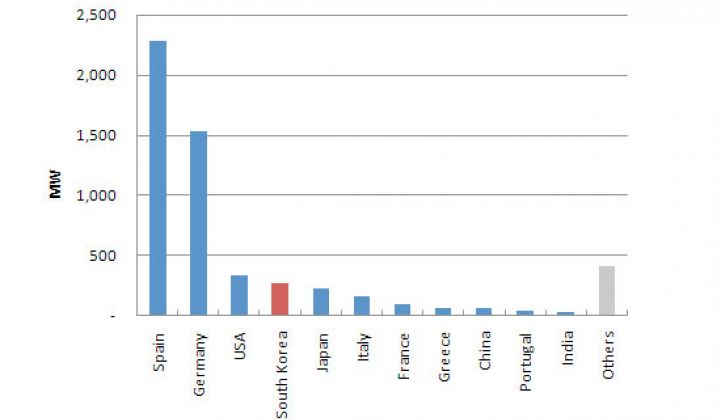South Korea increased the country's solar energy generation capacity by six times in 2008 when it installed an estimated 274 megawatts worth of systems, according to market research firm Displaybank Friday.
The Korea-based market research firm examined only power projects using solar panels. The 2008 figure makes South Korea the fourth largest market worldwide for solar-panel installations (and the largest one in Asia), Displaybank said. Spain ranked No. 1 (2.28 gigawatts), followed by Germany (1.53 gigawatts) and the United States (333 megawatts).
Overall, the world installed 5.5 gigawatts worth of solar energy systems in 2008, up from 2.4 gigawatts in 2007.
Although Korea is a small country, its government has created policies and invested heavily in boosting the country's renewable energy generation. The country has a feed-in tariff program modeled after the one in Germany, where utilities are required to buy solar power at government-set rates. Those rates are higher than the prices for conventional electricity, making installing and operating solar power projects a lucrative venture.
The government's efforts have made Korea an attractive market to solar energy equipment makers and project developers in other countries. Companies such as Epuron from Germany, Solar Power in Roseville, Calif. and Evergreen Solar in Marlboro, Mass., have inked deals to sell panels and install (see Epuron Expands into South Korea and South Korea Expands Solar Production).
SunPower, a U.S. solar panel maker and power project developer, has a joint venture in Korea called Woongjin Energy Co., which makes silicon ingots for manufacturing solar cells. SunPower announced the partnership with Woongjin Holdings Co. back in November 2007, and said at the time that it was going to spend $250 million buying the ingots from the joint venture over a five-year period.
Korea also has a homegrown solar energy industry. The country is home to some of the world's largest makers of flat display panels, whose manufacturing processes are similar to making solar panels. Last October, LG Electronics said it was converting one of its plasma production lines in Korea to make solar cells.
In 2008, Hyundai Heavy Industries built its solar cell factory, which has an annual production capacity of roughly 30 megawatts. Hyundai has a $40 million deal to sell modules to MHH Solartechnik in Germany starting this year.
Other Korean solar energy equipment companies include DC Chemical, Smart Applications, Nexolon, Kyungdong Photovoltaic Energy and NeosemiTech, according to a recent Greentech Media solar market report, PV Technology, Production and Cost, 2009 Forecast.
The domestic solar cell and panel producers only contributed to 60 megawatts of the 274 megawatts in new installations, said Displaybank. Most of the rest came from Europe, the United States and Japan.
Join industry leaders and influencers at Surviving the Shakeout: Greentech Media’s 2009 Solar Industry Summit in Phoenix, Ariz., April 14–15.




